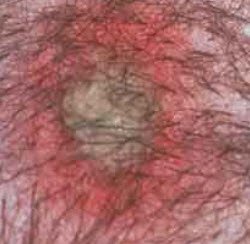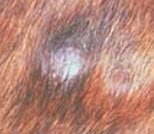Dog Lumps on Skin
" Dog lumps on skin are a type of dog skin problem that refers to nodular growth, most probably involving epithelial (outer skin surface) tissues, but any lump may have roots deep in the cutaneous (lower skin surface) tissues. The term, “Lumps” usually refers to a tumor, cancer or some uncontrollable growth, but it is not always the case. Not all lumps are tumors, cancerous or dangerous at all. Types of canine lumps on skin include benign tumors, malignant tumors, cysts, warts, edema, hematomas or inflammatory swellings. Hematomas (blood clot beneath skin), edemas (fluid below the skin) and inflammatory dog lumps on the skin appear reddish to brownish, warm when touched, painful and contain fluids or cellular content which can be felt on palpation (when touched). Tumors on other hand may be benign (slow growing) or malignant in nature. Diagnosis of lumps on dog skin may require the history of the problem, clinical examination and laboratory testing. Dog lumps which do not cause any damage to the dog, are usually not treated, but it is highly recommended that these should be referred to a veterinarian for examination, as these may end with a secondary bacterial infection in mild cases, and a life threatening cancerous development in severe cases. Different drugs and some specific surgical procedures may be required for effective treatment. ."
Morphological (structural) Characteristics of Dog Lumps on Skin:
Dog lumps on skin are specifically those mounts, growths and swellings on the skin which usually do not have roots deep in the skin. In most cases these lumps only involve epithelial and sub cutaneous tissues of the skin only. Sometimes the term “lump” is specifically used to refer to tumors or cancerous developments on the surface of skin, but some other forms of swellings and developments such as abscesses, edemas (fluid under skin), hematomas (blood clot) and inflammatory swellings are forms of canine lumps on skin. Morphologically and characteristically, lumps on the skin and beneath the skin have been reported to have different in pathological effects (effect on the condition of) on a dog’s body. Lumps on dog skin usually are not dangerous, do not penetrate into deeper tissues of the skin and are easier to treat. There may be a subsidiary or lower part of those lumps which occur under skin tissues.
Causes of Dog Lumps on Skin:
The most common forms of dog lumps on skin usually are caused by any inflammatory response, any allergy, wasp bite; sting etc. which may cause infiltration of inflammatory cells on skin surface, thus causing typical signs of inflammation such as pain, redness, loss of function, warm areas on the skin and swelling.
Accumulation of fluids or blood content under the cutaneous tissues of the skin may result in edemas (fluid under skin) or hematomas (dog blood clot under skin) respectively. These forms appear as bumps on the skin and are usually painful, warm and spongy when touched. Opportunistic bacteria finds these mediums suitable for multiplication, thus secondary infections are possible in these types of lumps on dog skin, if not treated properly.
Tumors, cancers or uncontrollable cellular growth are the most complicated forms of dog lumps on skin. These may be either benign or malignant (cancerous) in nature. Among tumors, benign tumors are the most commonly occurring lumps on dog skin, these are not dangerous, cannot spread to other parts of the body, and usually have no connection with any deeper tissues. On the other hand, malignant tumors or “true cancers” can spread to other parts of the body, have a connection with deeper tissues and is usually lethal. Malignant tumors appear as small nodular lumps in the initial stages, latterly these cause severe damage and lesions over the skin.
Pictures of Dog Lumps on Skin
Dog Skin Papule: A dog skin papule are small skin lumps that are 1/3 inch (1 CM) in diameter. It could indicate inflammation due:
- bacterial infection (bacterial folliculitis)
- fungal condition (fungal folliculitis)
- mange or scabies (demodicosis)
- sensitivity to a flea bite
- sensitivity to a mosquito bite
- exposure to an allergen
- autoimmune skin disease
- reaction to a drug your dog is taking.
- early neoplasm (uncontrolled cell growth).

Picture of Lumps on Dog Skin - Papule
Dog Skin Pustule: These are small areas on the skin that are pus filled. Pus is usually comprised of a substance called neutrophils, which are white blood cells attacking any bacteria or fungus causing the condition. A veterinarian will take a sample of the dog skin pustule for examination in a laboratory. Common causes of this condition include:
- bacterial infection
- fungal infection
- autoimmune skin disease
- sensitivity to an insect bite
- skin reaction to something a dog came in contact with (hypersensitivity

Picture Dog Skin Lump - Pustule
(Source: Dr. Thierry Olivry)
Dog Skin Vesicle or Bullea: This is a small round dog skin problem that is filled with clear fluid. They can move to different areas. Larger vesicles are referred to as bullea. This dog skin condition is caused by:
- Immune-mediated skin diseases
- congenital (inherited) skin diseases
- dog skin viruses
- irritants (called irritant dermatitis)

Picture of Dog Skin Lump - Vesicle
(Source: Dr. Thierry Olivry)
Dog Skin Wheal:A wheal is a round raised skin lesion that often goes away or disappears in a matter of minutes or hours. Possible causes include:
- urticaria (dog skin hives)
- insect bites
- hypersensitivities such as an allergic reaction
- drug reaction
- infection
- ,emotional stress

Picture of Dog Skin Wheal
Dog Skin Nodule: A nodule is a round elevated dog skin lump that is raised approximated 1/3 of an inch (1 cm) off the skin. It extends from the skin surface to deeper layers of the skin. It can be due to inflamed skin cells or a neoplasm (out of control or cancerous cells).
Possible causes of a nodule dog skin problem include:
- Sterile granulomatous diseases (inflamed cells)
- bacterial infection
- fungal infections
- neoplastic diseases (abnormal tissue growth)
- ,calcinosis cutis (calcium salts in the skin tissue

Picture of Dog Lump on Skin - Nodule
Dog Skin Tumor: A canine tumor is a larger skin mass that in on the surface of the skin and is deeper into the skin tissue called subcutaneous tissue. Possible causes of this dog skin condition includes:
- inflammatory cells
- neoplastic cells (uncontrolled or abnormal cell growth)
- bacterial skin disease
- fungal skin infection

Picture Dog Skin Tumor
Diagnosis of Dog Lumps on Skin:
A history of lumps on the skin, including duration (length of time its been on the skin), type, developments, any discomfort it causes to dog etc., clinical examination for its color, appearance, consistency and any content it may contain should be assessed. Laboratory procedures such as a biochemical profile of the content, biopsy and pathological sample assay can help in describing the cause and possible outcome of any dog skin lump.
Most lumps on dog skin do not usually cause any damage; they mostly are common edemas, hematomas (in case of close wounds), inflammation or benign tumors. Malignant or life threatening forms of lumps in the clinical stages appear as a lesion, but several small lumps dispersed on skin surface can be suspected for a malignancy that is in its advanced stages.
Treatment of Dog Lumps on Skin:
Treatment is dependent upon the diagnosis. Inflammatory lumps can be treated by placing ice cubes over it. This will reduce the activity of any inflammatory cells, thus causing immediate relief. The lump will decrease over time. The use of anti inflammatory drugs can help too, but should only be used if general signs of fever and illness are noted.
Hematomas and edemas should be surgically drained using a minor vertical incision, not more then half a centimeter, with pressure applied at the base of the lump. After complete drainage, the cavity should be filled with preparations (powder or paste) containing neomycin (an antibiotic).
Dog lumps on skin, if caused by allergic reactions can be either treated by using anti–allergy drugs and in support; herbal and/or homeopathic preparations can help such as Allergy Itch Ease . Benign tumors should be left untreated if they do not cause any damage to the dog or do not grow with time. Surgical removal of a benign tumor may lead to an edema or hematoma and in complicated cases; these may develop into a malignant form.
Malignant tumors should be diagnosed in its initial stages, i.e. when they appear as small lumps or nodular bodies. Complete elimination is possible in this stage. In more advanced cases chemotherapy and other advance treatments for cancer can not heal the condition.
|
|
References:
Veterinary Clinician Manual (Royal Publishers UK. 1994)
Dermatology for the Small Animal Practitioner, Mueller R.S. (Ed.).
American College of Veterinary Dermatology
This site accepts advertising and other forms of compensation for products mentioned.
Such compensation does not influence the information or recommendations made.
We always give our honest opinions, findings, beliefs, or experiences.
All rights reserved. © 2018 Dog Health Handbook.




